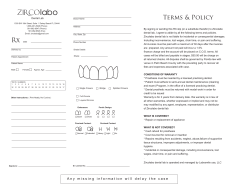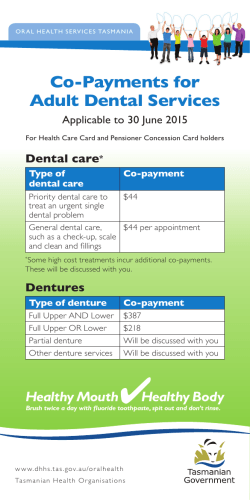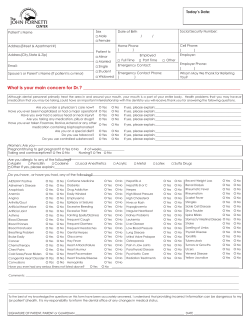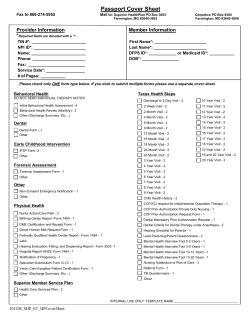
evaluation of the skeletal maturation using lower canine mineralization
Orthodontics Original Article EVALUATION OF THE SKELETAL MATURATION USING LOWER CANINE MINERALIZATION 1 GHULAM RASOOL, BDS, MCPS (Ortho), FCPS, (Ortho) 2 UMAR HUSSAIN, BDS 3 SYED SULEMAN SHAH, BDS ABSTRACT Successful orthodontics diagnosis, treatment planning and clinical procedures require a thorough understanding of growth and development. Prior knowledge to quantify the growth remaining would be extremely useful for predicting treatment results. The aim of this study was to investigate the relationship between dental age based on the calcification stages of the mandibular canine and skeletal maturity stages using cervical vertebral maturation among Peshawar population and to determine the clinical value of the mandibular canine as a growth evaluation index. Panoramic and lateral cephalograoms of 100 patients from the department of orthodontics Khyber College of Dentistry were used to determine the dental calcification and cervical vertebral maturation(CVM) stages by two postgraduate trainees. Dental calcificationof mandibular canine was determined according to Demirjin et al and CVM staging was done according to Baccetti et al. The spearman rank correlation was determined between CVM and dental calcification stages. The highest correlation were among the CS1 and stage E(100%), CS2 and stage F (75%), CS3 and stage G (36%), and CS4 and stage H(51%). The correlation between CVM and dental calcification were highly significant ( r=0.871 p=0.000). Key Words: skeletal maturation, calcification, mandibular canine, growth. INTRODUCTION Successful orthodontic diagnosis, treatment planning, and clinical procedures require a thorough understanding of growth and development.1 It is well established that in growing subjects facial skeletal disharmonies, i.e. skeletal malocclusions, can be correctly treated by orthopaedic approaches. Such skeletal imbalances include; transverse, vertical and sagittal maxillary deficiency or excess and mandibular deficiency or prognathism which are relatively common features in certain ethnic populations .2,3 The important growth phases in such orthodontically treated subjects are; pre-pubertal, pubertal and post-pubertal growth phases, each of which is characterized by differential growth of maxilla and mandible.4 Professor & Head of Orthodontics Department, Khyber College of Dentistry, Peshawar University Campus, Address: House #4 Street 4, Sector J-I, Phase-II, Hayatabad, Peshawar E-mail: [email protected] Cell # 0333-9126029 2 FCPS Resident Orthodontics 3 FCPS Resident Orthodontics Received for Publication: October 1, 2014 Revision Received: October 30, 2014 Revision Accepted: November 2, 2014 1 Pakistan Oral & Dental Journal Vol 34, No. 4 (December 2014) Treatment timing plays a crucial role in the outcomes of all dentofacial orthopaedic treatments for dentoskeletal imbalances in growing patients.5 Prior knowledge to quantify the growth remaining would be extremely useful for predicting treatment results.6 For growth modification to be successful, it is absolutely essential that it starts at the right time. Optimal timing for treatment is different in various malocclusions. According to Bacetti et al,5 treatment protocols for enhancing or restraining maxillary growth is more effective when performed before the adolescent growth spurt, whereas treatment regimens aimed to enhance or restrain mandibular growth produce greater effects when performed during the pubertal growth spurt period. Tooth eruption or emergence is poor indicator of skeletal maturity.4,7,8 However, dental calcification stages detected through radiographic methods appear to be highly correlated to skeletal maturity.9,10 Dental maturity assessment can be simply carried out on panoramic radiograph that are routinely used for diagnosis in orthodontics with minimal irradiation to the patient. In pediatric patient, the use of a thyroid collar is mandatory while taking cephalometric radio629 Evaluation of the skeletal maturation graphs. However, Wiechmann et al11 and Sansare et al12 concluded that the thyroid collar masks landmarks mainly used for analysis of skeletal maturity. Perinetti et al13 analyzed the diagnostic ability of the dental maturation phases for the skeletal maturation using the cervical vertebral maturation stages and concluded that dental and skeletal maturity are highly correlated. Solmaz Valizadeh and colleagues14 investigated the correlation between the stages of tooth calcification and the cervical vertebral maturation in Iranian females. They observed significant correlations between the two stages in the mandibular first and second premolars, canine and central incisors. Krisztina and co-workers15 evaluated the skeletal maturation using lower first premolar mineralization and reported significant correlation (r = 0.871, p <0.001) between CVM and Demirjian's index. The aim of this study was to investigate the relationship between dental age based on the calcification stages of the mandibular canine and skeletal maturity assessment using cervical vertebral maturation among Peshawar population and to determine the clinical value of the mandibular canine as a growth evaluation index. METHODOLOGY A retrospective cross-sectional study was conducted from 1st July 2014 to 15th September 2014. Hundred subjects (both male and females) with age ranging from 8 to 14 years were included in the study. Panoramic and lateral cephalometric radiographs were taken from the records of patients in department of Orthodontics, Khyber College of Dentistry Peshawar. Sampling was performed according to the convenient sampling method. The inclusion criteria were: • Pakistani Nationality • No systemic disease that could affect general development like hormonal diseases • No history of orthodontic treatment • lateral cephalometric and panoramic radiographs available with high clarity and good contrast taken at the same day • No missing or anomalies (trauma, injury, impaction, transposition) in dentition • No history of trauma or surgery in the neck or dentofacial region. Lateral cephalometric radiograph of each individual was taken with a universal counter balancing type of cephalostat at Radiology Department of Khyber College of Dentistry, Peshawar. Kodak' X-ray films (8×10) were Pakistan Oral & Dental Journal Vol 34, No. 4 (December 2014) exposed to 70 KVp, 45 mA for an average of 1.8 sec, with a tube to film distance of 6 feet. All lateral Cephalograms were placed on illuminator and determination of CVM stages were done by two postgraduate trainees. Panoramic radiographs were also placed on illuminator to determine the calcification stage of permanent mandibular canine on the left side. We did not consider the maxillary canine because superimposition of the anatomic structures in this area does not always allow assessment of the accurate developmental stage of the teeth. Tooth calcification stages were rated from A to H according to the method introduced by Demirjian et al.16 The characteristics of stages are described in Table 1. Cervical vertebral maturation staging (CVMS) was evaluated on lateral cephalometric radiographs, according to the method described by Baccetti et al.17 This method has been proved useful in the evaluation of skeletal maturation in a single cephalogram. This method analyzes the morphology of the second (C2), third (C3), and fourth (C4) cervical vertebrae and the patient is classified into one of six stages; CVMS I, CVMS II, CVMS III, CVMS IV, CVMS V and CVMS VI which are given below. Stage 1 (Initiation): Great amount of pubertal growth expected (80 to 100%). Inferior borders of C2, C3 and C4 are flat at this stage. The vertebrae are wedge shaped, and the superior vertebral borders are tapered from posterior to anterior. Stage 2 (Acceleration): Growth acceleration begins at this stage. Significant pubertal growth expected (65% to 85%). Concavities are developing in the inferior borders of C2. The inferior border of C3 and C4 is flat. The bodies of C3 and C4 are trapezoidal in shape. Stage 3 (Transition): Moderate pubertal growth expected (25% to 65%). Distinct concavities are seen in the inferior borders of C2 and C3. A concavity is beginning to develop in the inferior border of C4. Atleast one of C3 or C4 bodies still retains a trapezoidal shape. Stage 4 (Deceleration): Reduced expectation of pubertal growth (10 to 25%). Distinct concavities are seen in the inferior borders of C2, C3 and C4. The vertebral bodies of C3 and C4 are rectangular horizontal in shape. Stage 5 (Maturation): Final maturation of the vertebrae took place during this stage. Insignificant pubertal growth expected (5 to 10%). More accentuated concavities are seen in the inferior borders of C2, C3 and C4. The bodies of C3 and C4 are square in shape. Stage 6 (Completion): Pubertal growth completed at this stage (little or no growth expected) Deep concavities are seen in inferior border of C2, C3 and C4. 630 Evaluation of the skeletal maturation The bodies of C3and C4 are square or are greater in vertical dimension than in horizontal dimension. Since the radiographs were selected from existing data, there was no risk of additional radiation exposure to patients. All radiographs were analyzed by two postgraduate trainees of orthodontics who examined panoramic and lateral cephalometric radiographs separately. Cases with disagreement between the observers were excluded. To examine the intra-observer reliability, 20 subjects were reevaluated by both methods. The agreement was assessed by weighted kappa statistics. Kappa was (0.83 ± 0.05) for determination of tooth calcification stages and (0.91 ± 0.04) for cervical maturation. The results revealed that the reproducibility of the diagnosis in our rater was almost perfect. Data were presented as percentages. The Spearman's correlation coefficients were used to study the correlation between cervical vertebral maturation stages and dental calcification stages. P<0.05 were considered statistically significant. SPSS 16.0 was used for statistical analysis. RESULTS The mean age was 11.48±1.9 years. Female to male ratio was 1.22:1. Thirteen year was the most common age group (31%) followed by age 12 (17%). Females were more than males patients. The common CVM stage was CS2 followed by CS4. The most prevalent calcification was stage G followed stage H. (ref. Table 2) The highest correlation were among the CS1 and stage E (100%), CS2 and stage F (75%) , Cs3 and stage G (36%), and CS4 and stage H (51%). The common CVM stage was CS2 in this study and calcification stage was stage G. (ref. Table 3). The correlation between CVM and dental calcification were highly significant (r=0.871 and p=0.000). (ref. Table 4) The most common CVM stage was CS4 followed by CS2 while in female the most common was CS3 and CS4 followed by CS1. (Table 5) DISCUSSION The orthodontists should consider both the diagnostic records and the growth potential of the jaws. Although orthodontic treatment is able to modify the jaw growth and improve the dentofacial relationships, its ability is restricted to the extent of jaw growth that might occur. Many investigators have studied the optimal time for treating patients with orthodontic functional appliances and it is known that periods of accelerated growth can contribute to correct those kinds of skeletal imbalances.18 The pubertal growth spurt can be assessed by some indicators such as increase in body height,19 skeletal maturation of the hand-wrist20 Pakistan Oral & Dental Journal Vol 34, No. 4 (December 2014) and cervical vertebral maturation.21 In this study, we investigated the correlation between cervical vertebral maturation stages and the calcification stages of mandibular canine to know the correlation between the tooth calcification and the CVM stages. It is generally accepted that a strong relationship do exists between skeletal, sexual, and somatic maturation,22 but contributions to the correlation between dental age and skeletal maturity are inconclusive.23 Lack of concordance may result, at least in part, from differences in evaluation methods of dental and skeletal maturity. Discrepancies in the number, age, and racial background of the studied subjects conditioned by ethnic origin, climate, nutrition, socio-economic status, and industrialization are the main reasons for variability of the results in many studies.24 Panoramic radiographs are routinely available in orthodontic departments and the method of dental age determination described by Demirjian et al is based on the calcification stage of the seven left mandibular teeth, which are clearly visible on radiographs. The criteria of the method comprise the shape and proportion of root length (using the relative value to crown height rather than absolute tooth length) and thus the influence of radiographic projection is minimal.6 In the majority of available studies, skeletal maturity was assessed by means of hand wrist radiographs and the dental calcification in which the mandibular region is clearly visible.25-27 So panoramic radiographs were used in current the study for determination of dental calcification stages. There are numerous standard scales for grading the dental calcification stages. The method proposed by Demirjian et al5 was selected in the present study because its criteria consist of distinct details based on shape and proportion of root length, using the relative value to crown height rather than on absolute length. Foreshortened or elongated projections of developing teeth will not affect the reliability of assessment.28 The skeletal age for each hand-wrist radiograph can be used according to the method described in the atlas of Greulich and Pyle.29 Which is quick and relatively easy to learn and carry out. Because it is less time consuming in practice than the bone stage and weighting system of Tanner et al30 shows greater reproducibility between observers, The Greulich and Pyle method seems to be highly practical for clinical use in skeletal age assessment.31 It is, however, essential to know that the differences exists between the local population and the reference population used to define the standards in the atlas. Thus, the given skeletal age values or standard plates might differ and should be recalibrated for each local population.26 Solmaz et al14 showed in a study which consists of four hundred females (age range, 8 to 14 years). They 631 Evaluation of the skeletal maturation TABLE 1: STAGES OF TOOTH CALCIFICATION C TO H, ACCORDING TO DEMIRJIAN ET AL. Stage C Complete enamel formation on occlusal surface, dentin formation started, curved pulp chamber, no pulp horns Stage D Complete crown formation to CEJ*, root formation started, curved pulp chamber, pulp horns begin differentiation Stage E Root shorter than crown, straight pulp chamber walls, pulp horns more differentiated, radicular bifurcation calcification started Stage F Isosceles triangle form of the pulp chamber, the root length equal to or greater than crown, distinct root form because of sufficiently calcified bifurcation Stage G Parallel walls of the root canal, open apical end Stage H Completely closed root apex, uniform periodontal membrane surrounding the root and apex TABLE 2: FREQUENCIESOF AGE, GENDERS, CERVICAL VERTEBRAL MATURATION, AND CALCIFICATION STAGES OF PATIENTS Age %ages Genders %ages CVM Stages %ages Calcification stages %ages 7 1 Male 45 CS1 10 E 7 8 10 CS2 32 F 24 9 9 CS3 21 G 38 10 9 CS4 28 H 31 11 13 CS5 7 12 17 CS6 2 13 31 14l 10 Total 100 Total 100 Total 100 Female Total 55 100 TABLE 3: CORRELATION BETWEEN CERVICAL VERTEBRAL MATURATION AND MANDIBULAR CANINE CALCIFICATION STAGES C Cervical vertebral maturation stage (%) CS1 CS2 CS3 CS4 CS5 CS6 Mandibular Canine E 7 0 0 0 0 0 Calcification Stages F 3 18 2 1 0 0 G 0 13 14 11 0 0 H 0 1 5 16 7 2 TABLE 4: CORRELATION BETWEEN CERVICAL VERTEBRAL MATURATION AND DENTAL CALCIFICATION STAGES IN MANDIBULAR CANINE Pearson across mandibular canine calcification stages 0.781 P-value 0.000 Pearson correlation across cervical vertebral maturation stages 0.781 Pakistan Oral & Dental Journal Vol 34, No. 4 (December 2014) P-value 0.000 632 Evaluation of the skeletal maturation TABLE 5: CERVICAL VERTEBRAL MATURATION OF PATIENTS ACCORDING TO AGE Gender Male Female CVM stage Mean age (years) CS1 8.50 CS2 11.33 CS3 11.38 CS4 13.00 CS5 14.00 CS1 8.00 CS2 10.12 CS3 11.77 CS4 12.92 CS5 12.20 CS6 14.00 Fig 1: CVM staging according to Baccetti et al determine the dental maturational stage, calcification of the mandibular teeth except for third molars. To evaluate the stage of skeletal maturation, cervical vertebral morphologic changes were assessed on lateral cephalometric radiographs according to the method explained by Baccetti et al. Spearman's correlations between the teeth calcification and cervical vertebral maturation stages – except for the permanent incisors and first molar – were found to be high (r=0.702-0.75) and they also reported that a significant relation between the two classifications exists (P < 0.001). The current study differs in some respects from Solmaz’s study; only mandibular canine calcification was determined in this study and both genders were included. The present study results are in agreement with the Solmaz et al (r= 0.781 and p= 0.000). Sachan and colleagues32 evaluated the relationship of skeletal maturity by cervical vertebral maturation indicators and canine calcification stages. Their study consisted of randomly selected 90 children from Lucknow population with 45 males (age range 10-13 years) and 45 females (age range 9-12 years). Lateral Cephalogram, and periapical x-rays of maxillary and mandibular right canines were taken. Mean, standard deviation was calculated of different groups. Correlation was made among cervical vertebral maturation Pakistan Oral & Dental Journal Vol 34, No. 4 (December 2014) and canine calcification stages at various age groups. They also studied the correlation between CVM and hand wrist radiograph. They showed strong correlation between skeletal maturation indicator and cervical vertebral maturation indicator for both male (0.849) and female (0.932), whereas correlation between skeletal maturation indicator and canine calcification was good for both male and female (0.635, 0.891). In the current study both genders were studied jointly and comparison with the hand wrist radiographs were not performed to avoid unnecessary radiation to patients. The present’s study results are comparable to Sachan et al. Goyal and co-workers 33 assessed, the relationship between cervical vertebrae maturation and mandibular canine calcification stages to know whether the mandibular canine calcification stages can be used as indicators to determine skeletal maturity. A descriptive, retrospective, and cross-sectional study was designed. Pre-treatment orthopantomograms (OPGs) and lateral cephalograms of 99 males and 110 females of Rwanda ethnicity were selected. The cervical vertebrae maturation index (CVMI) proposed by Hassel and Farman was used to evaluate the skeletal maturation level, and the mandibular canine calcification stages were assessed with the Demirjian Index (DI). A significant correlation was found between the CVMI and DI stages, as evaluated by the correlation coefficient values (0.599 for males and 0.719 for females). Canine stage F and canine stage E could represent highest correlation with CVMI 2 stage and indicate the onset of a period of accelerating growth. In the present study CVM assessment was made according to Baccetti et al17 and stage E showed highest correlation with CVM1 (100%) (Table 5). Goyal’s study support this study as far as stage F with CVM2 and coefficient of correlation between DI and CVMI is concerns. REFERENCES 1 LevihnWC. A cephalometric roentgenographic cross-sectionalstudy of the craniofacial complex in fetuses from 12 weeks to birth.Am J Orthod 1967; 53: 822-48. 2 Perinetti G, Cordella C, Pellegrini F, Esposito P. The prevalence of malocclusal traits and their correlations in mixed dentition children: results from the Italian OHSAR Survey. Oral Health Prev Dent 2008; 6:119–29. 3 Proffit WR, Fields HW Jr, Moray LJ. Prevalence of malocclusion and orthodontic treatment need in the United States: estimates from the NHANES III survey. Int J Adult Orthodon Orthognath Surg 1998; 13:97–106. 4 Hagg U, Pancherz H. Dentofacial orthopaedics in relation to chronological age, growth period and skeletal development. An analysis of 72 male patients with Class II division 1 malocclusion treated with the Herbst appliance. Eur J Orthod 1988; 10:169–76 5 Baccetti T, Franchise L, McNamara JA. The cervical vertebral maturation method for assessment of optimal treatment timing in Dentofacial orthopaedics. Semin Orthod 2005; 11:119-29. 633 Evaluation of the skeletal maturation 6 Krailassiri S, Anuwoongnukroh N, Dechkunakorn S. Relationship between dental calcification stages and skeletal maturation indicators in Thai individuals. Angle Orthod 2002; 72:155-66. 21 San Roman P, Palma JC, Oteo MD, Nevado E. Skeletal maturation determined by cervical vertebrae development. Eur J Orthod 2002; 24(3):303–11. 7 Bjork A, Helm S.Prediction of the age of maximum pubertal growth in body height. Angle Orthod 1967; 37: 134-43. 8 Franchi L, Baccetti T,DeToffol L, Polimeni A, Cozza P. Phases of the dentition for the assessment of skeletal maturity: a diagnostic performance study. Am J Orthod Dentofacial Orthod 2008; 133: 395-400. 22 Demirjian A, Buschang PH, Tanguay R, Patterson D. Interrelationships among measures of somatic, skeletal, dental, and sexual maturity. American Journal of Orthodontics 1985; 88: 433-38. 9SierraAM.Assessmentofdentalandskeletalmaturity.Anewapproach.AngleOrthod1987;57:194-208. 10 Basaran G ,Ozer T, Hamamci N. Cervical vertebral and dental maturity in Turkish subjects .Am J Orthod Dentofacial Orthop2007; 131:447.e13-20. 11 Wiechmann D, Decker A, Hohoff A, Kleinheinz J, Stamm T. The influence of lead thyroid collars on cephalometric landmark identification. Oral Surg Oral Med Oral Pathol Oral Radiol Endod 2007; 104: 560-68. 12 Sansare KP, Khanna V,Karjodkar F. Utility of thyroid collars in cephalometric radiography. Dentomaxillofac Radiol 2011; 40: 471-75. 13 Perinetti G, Contardo L, Gabrieli P, Baccetti T, DiLenarda R. Diagnostic performance of dental maturity for identification of skeletal maturation phase. Eur J Orthod2 012; 34: 487-92. 23 Flores-Mir C, Mauricio FR, Orellana MF, Major PW. Association between growth stunting with dental development and skeletal maturation stage. Angle Orthodontist2005; 75: 935–40. 24 Różyło-Kalinowska I, Anna Kolasa-Rączka A, Kalinowski P. Growth assessment methods. The Eur J Orthod 2011; 33(1):7583. 25 Kamal MR, Goyal S. Comparative evaluation of hand wrist radiographs with cervical vertebrae for skeletal maturation in 10–12 year old children. J Ind Soci Pedod and Prev Dent 2006; 24: 127–35. 26 Helm S. Relationship between dental and skeletal maturation in Danish school children. J Dent Res 1990; 98: 313-17. 27 Mappes M, Harris EF, Behrents RG. An example of regional variation in the tempos of tooth mineralization and hand-wrist ossification. Am J Orthod Dentofac Orthoped 1992; 101: 145–51. 28 Fanning DA, Brown T .Primary and permanent tooth development. Aust Dent J 1971; 16:41–43. 14 Solmaz V, Eil N, Ehsani S, Bakhshandeh H. Corelation between Dental and Cervical Vertebral maturation in Iranian Females. Iran J Radiol 2013; 10(1):1-7. 29 Greulich WW, Pyle SI. Radiographic atlas of skeletal development of the hand and wrist. 2nd ed. Stanford,Calif: Stanford University Press;1959; 1-150. 15 Krisztina MI, Réka G, Zsuzsa B. Evaluation of the Skeletal Maturation Using Lower First Premolar Mineralisation. Acta Medica Marisiensi 2013;59(6): 289-92. 30 Tanner JM, KW, Cameron N, Carter BS, Patel J. Prediction of adult height from height and bone age in childhood. A new system of equations (tw Mark II) based on a sample including very tall and very short children. Archives of Disease in Childhood 1983; 58: 767–76 16 Demirjian A, Goldstein H, Tanner JM. A new system of dental age assessment. Hum Biol. 1973; 45(2):211–27. 17 Baccetti T, Franchi L, McNamara JA. An improved version of the cervical vertebral maturation (CVM) method for the assessment of mandibular growth. Angle Orthod 2002; 72(4):316–23. 31 Acheson RM,Vicinus JH, Fowler GB. Studies in their liability of assessing skeletal maturity from x-rays. PartIII. Greulich-Pyle atlas and Tanner-White house method contrasted. Hum Biol. 1966; 38:204–18. 18 Chen J, Hu H, Guo J, Liu Z, Liu R, Li F, et al. Correlation between dental maturity and cervical vertebral maturity. Oral Surg Oral Med Oral Pathol Oral Radiol Endod 2010; 110(6):777–83. 32 Sachan K, Sharma VP, Tandon P. A correlative study of dental age and skeletal maturation. Indian J Dent Res 2011; 22:882-86. 19 Nanda RS. The rates of growth of several facial components measured from serial cephalometric roentgenograms. Am J Orthod 1955; 41(9):658–73. 33 Goyal S, Goyal S, Gugnani N. Assessment of skeletal maturity using the permanent mandibular canine calcification stages. J Orthod Res 2014; 2:11-16. 20 Mito T, Sato K, Mitani H. Predicting mandibular growth potential with cervical vertebral bone age. Am J Orthod Dentofacial Orthop 2003; 124(2):173-77. Pakistan Oral & Dental Journal Vol 34, No. 4 (December 2014) 634
© Copyright 2025









